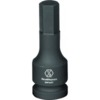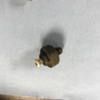Don't misunderstand, I'm not wishing that (any bad luck) on you.
Frozen head bolts are common on the old 2.0 L Fords with the aluminum heads and iron blocks. Not necessarily on a Cleveland block.
The choice of failure areas are not voluntary on your part. They are going to be, 1) the bolt comes loose and all is good (very possible) 2) the bolt snaps just above the top of the block (highly likely)3) the bolt comes loose but takes a part of the block with it (possible but not often seen).
You won't know until you roll the dice. You really need to soak where the bolt goes into the block with penetrating solvent. PB Blaster works well for us here.
Sometimes you need to heat the bolt red hot, then let it cool. Of course that sets the PB Blaster on fire since it is largely kerosene and you would have to cut the head of the bolt off to remove the head, then use a "stud puller" on it.
Frankly, if it doesn't come loose the first couple of shots with the impact wrench, it is a much safer procedure to take the entire mess to a machine shop and let them do it.
At least you won't break the block casting that way but using an end mill to get the broken stud out isn't as simple as it sounds.
You need to do that on a "mill". Once it is all set up, then yes, it's a piece of cake really.
You mill the stud out then you still need to use a tap to get the remainder of the bolt threads out of the block.
The Devil is in the details, i.e., getting it there and setting it up on the machine.

I wish you the best of luck and a simple and easy solution.





